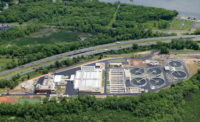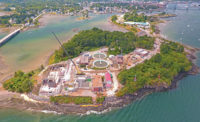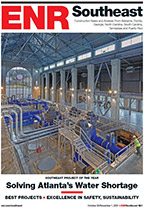Alewife Stormwater Wetland Project, Cambridge, Mass.
Although it began as an infrastructure solution to reduce combined sewer overflows (CSOs) and flooding of the Alewife Brook watershed, the 3.4-acre constructed wetland project wound up going much further. The team delivered the $17.9-million project within an urban parkland while incorporating recreational facilities and enhancing local wildlife habitat and flora.
Prior to the project, "the wooded wetland was more like a swamp with marsh and trees. Water discharged through an outfall pipe to Little River and Alewife Brook and then on to Boston Harbor," says John Struzziery, senior program manager at Kleinfelder, project designer. "We needed to shape it."
The constructed wetland—New England's largest—and outfall comprised the cornerstone of the CSO plan. Located within the 120-acre Alewife Reservation and part of the federally mandated Boston Harbor Cleanup, this was a city project on state-owned land. As such, it required legislative action and extensive coordination among all team players as well as state and local agencies to move forward.
The project called for complex engineering components including bending weir technology for controlling the amount of water going into the constructed wetland.
As existing utilities crossed the work zone, they needed to be relocated in advance of construction. The world's longest pilot tube auger bore was used to place high voltage cable, gas main and telecommunication systems under the river and wetland. The auger "left a smaller footprint on city-owned land without requiring further permits," Struzziery says. "It was a way of changing the construction method after the project was bid and getting the project done without further delay."
Ground water control required filtration in large settling tanks. But once the basin was built to a certain point, it could be used as a settling tank as well.
The team performed an impact study on night operations lighting for local wildlife. Because the site was isolated for construction with silt and snow fences, the project team strategically placed escape routes that trapped animals could use to get out of the work zone.
The project also involved planting 124,000 native species designed to provide food and cover, as well as building islands to provide breeding grounds for migrating birds that would be isolated from predators. It also included community open space resources such as an outdoor amphitheater, walking trails and boardwalk.
Judges noted the team's accomplishment on the infrastructure project itself, with one commenting that the team demonstrated a "really good" ability to enhance public space and reach out to the community.
Key Players
Owner City of Cambridge, Massachusetts Dept. of Public Works
General Contractor/Construction Manager P. Gioioso & Sons
Lead Design Firm/Structural and Civil Engineer Kleinfelder
Civil engineering and hydraulics subconsultant MWH Americas
Landscape subcontractor MON Landscaping Inc.
Landscape architect subconsultant MON Bioengineering Group








